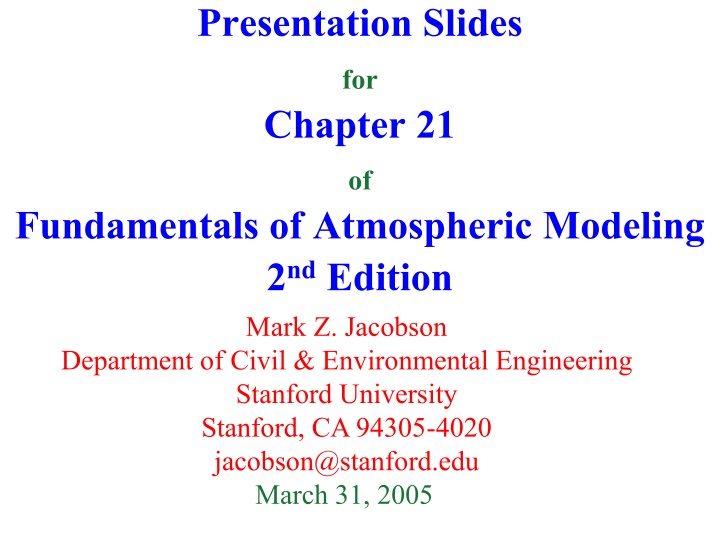
Steps in Atmospheric Model Formulation and Nested Domains Example
Explore the detailed steps in formulating atmospheric models, from initial conditions to boundary conditions, input data selection to running simulations. Get insights into nested domains and interpolation techniques for accurate model results.
Download Presentation

Please find below an Image/Link to download the presentation.
The content on the website is provided AS IS for your information and personal use only. It may not be sold, licensed, or shared on other websites without obtaining consent from the author. If you encounter any issues during the download, it is possible that the publisher has removed the file from their server.
You are allowed to download the files provided on this website for personal or commercial use, subject to the condition that they are used lawfully. All files are the property of their respective owners.
The content on the website is provided AS IS for your information and personal use only. It may not be sold, licensed, or shared on other websites without obtaining consent from the author.
E N D
Presentation Transcript
Presentation Slides for Chapter 21 of Fundamentals of Atmospheric Modeling 2ndEdition Mark Z. Jacobson Department of Civil & Environmental Engineering Stanford University Stanford, CA 94305-4020 jacobson@stanford.edu March 31, 2005
Steps in Model Formulation 1. 2. 3. 4. 5. 6. 7. 8. 9. 10. Set initial conditions Define purpose of model Determine scales of interest Determine dimension of model Select physical, chemical, dynamical processes treated Select variables Select computer architecture Write code for model Optimize memory and speed of model Select time steps and time intervals
Steps in Model Formulation 11. Set boundary conditions 12. Select input data 13. Select ambient data for comparison 14. Interpolate data and model results for inputs and outputs 15. Select or write algorithms for statistics and graphics 16. Run model simulations 17. Run sensitivity tests 18. Improve model based on results
Number of Array Points in Model ( )N3D+NSN2D Nmin= NM+NG+NDNBNV+NR (21.1) Example 21.1: Number of meteorological variables Number of gases Number of aerosol and hydrometeor distributions Number of size bins per distribution Number of components per size bin per distribution Number of radiative variables: Number of three-dimensional grid cells Number of surface variables Number of two-dimensional grid cells Number of array points required 10 100 5 20 30 2 50,000 6 2500 156 million
Example of Nested Domains Latitude (degrees) Fig. 21.1
Nesting Boundary Conditions Variable values in buffer zone of progeny domain (21.4) par prog at0+hnest,k +Fkat0+ m-1 1+Fk ( )h,k prog at0+mh,k = Relaxation coefficient (21.5) ( ) hnest-h h ) M 1-k ( Fk= 1-e
Inverse Square Interpolation Domain of influence around point O. Letters A, B, C, D, and E represent locations where data are available for interpolation to point O. The lines represent division of the domain of influence into sectors. rI Fig. 21.2b
Inverse Square Interpolation Inverse square interpolation VO VAdAO (21.7) -2+VBdBO dAO -2+VCdCO -2+dBO -2+VDdDO -2+dDO -2+VEdEO -2+dEO -2 -2+dCO -2 Modified inverse square interpolation (21.6) -2+qBVBdBO qAdAO -2+qCVCdCO -2+qCdCO -2+qDVDdDO -2+qDdDO -2+qEVEdEO -2+qEdEO -2 VO qAVAdAO -2+qBdBO -2
Bilinear Interpolation Location of point O in a rectangle with points B, C, D, and E at the corners (21.10) VO ABVB+ ACVC+ ADVD+ AEVE AB+ AC+ AD+ AE Fig. 21.3
Statistics Overall normalized gross error (21.11) Pxi,tj-Oxi,tj Oxi,tj Ntim Nobs 1 NGE = NtimNobs j=1 i=1 Location-specific normalized gross error (21.12) Px,tj-Ox,tj Ox,tj Ntim 1 NGEx= Ntim j=1
Statistics Time-specific normalized gross error (21.13) Pxi,t-Oxi,t Oxi,t Nobs 1 NGEt= Nobs i=1 Unpaired-in-time, paired-in-space error (21.14) Nobs Ntim Ntim Ntim 1 UTPSE= - Pxi,tj Oxi,tj Oxi,tj Nobs i=1 j=1 j=1 j=1
Statistics Unpaired-in-time, unpaired-in-space error Ntim (21.15) Nobs Ntim Nobs Ntim Nobs UTUSE= - Pxi,tj Oxi,tj Oxi,tj j=1 i=1 j=1 i=1 j=1 i=1 Normalized bias (21.16) Pxi,tj-Oxi,tj Oxi,tj Ntim Nobs 1 NB= NtimNobs j=1 i=1
Statistics Biased variance (21.17) N 2=1 ( ) 2 su Vi-V N i=1 Biased variance of time-specific normalized gross error (21.18) 1 Nobs 2 Pxi,t-Oxi,t Oxi,t Nobs 2 su,NGEt = -NGEt i=1
Statistics Paired peak accuracy (21.19) PPA=P x, t-O x, t O x, t Temporally-paired peak accuracy (21.20) TPPA=Px, t-Ox, t Ox, t
